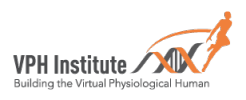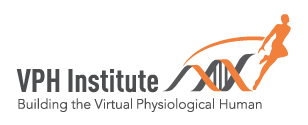Keynote #1 Dirk Drasdo
Dirk Drasdo – Plenary Speaker Wednesday, Sep 04, 9.00 am – 10.00 am
Towards a full digital liver twin: drug injury, regeneration and disease progression
The liver is the main detoxifying organ with a significant regenerative capacity. It is composed of smallest repetitive functional tissue units (“lobules”) that possess a complex microarchitecture to guarantee optimal contact between blood entering the liver and the hepatocytes that detoxify the blood from toxins. Blood entering the liver enter each lobule by portal conduits and exits the lobule via a vein in the center of the lobule. Liver is zonated: different zones in the liver lobule take over different functions. Overdosage of paracetamol (acetaminophen, APAP) is the main reason for acute liver failure destroying hepatocytes situated close to the central vein. The lesion size is greatest about a day after drug administration, while after this a regeneration process is triggered, the lesion is usually closed within 1-2 weeks. In mice, repetitive administration of APAP can lead to fibrosis, characterized by collagen tissue deposited in the damage zone and forming a network.
In this talk a digital twin model will be represented resolving the liver lobule at microarchitectural level recapitulating the main mechanisms of acute drug induced damage and regeneration. The model includes the key APAP detoxification reactions in each hepatocyte [1], blood flow and metabolite transport with the blood, the regeneration process with a minimal through still complex network of cell-cell communications [2], as well as the impaired ammonia detoxification as a consequence of the damage.
Finally, it will be sketched how the model is able to address aspects of fibrosis development [3] and of the ammonia detoxification in presence of fibrotic scar tissue, and, how the model can be used to transfer from one species to another [6] and to inform clinicians [5,6]. All simulations are confronted with data.
[1] Dichamps J. et. al. Front. Bioeng. Biotechnol, 2023; [2] Zhao J et. al., iScience. 2023; [3] Zhao J, et al. https://inria.hal.science/hal-03512915. [4] Hoehme S et. al.. iScience. 2022;
Drasdo D, Zhao J. J. Hepat. 2023; [6] Link et. al., https://doi.org/10.1101/2023.12.12.571289 (Gut, accepted)
© Dirk Dasdro
Keynote #1 Dirk Dasdro
Dirk Dastro – Plenary Speaker Wednesday, Sep 04, 9.00 am – 10.00 am
Towards a full digital liver twin: drug injury, regeneration and disease progression
The liver is the main detoxifying organ with a significant regenerative capacity. It is composed of smallest repetitive functional tissue units (“lobules”) that possess a complex microarchitecture to guarantee optimal contact between blood entering the liver and the hepatocytes that detoxify the blood from toxins. Blood entering the liver enter each lobule by portal conduits and exits the lobule via a vein in the center of the lobule. Liver is zonated: different zones in the liver lobule take over different functions. Overdosage of paracetamol (acetaminophen, APAP) is the main reason for acute liver failure destroying hepatocytes situated close to the central vein. The lesion size is greatest about a day after drug administration, while after this a regeneration process is triggered, the lesion is usually closed within 1-2 weeks. In mice, repetitive administration of APAP can lead to fibrosis, characterized by collagen tissue deposited in the damage zone and forming a network.
In this talk a digital twin model will be represented resolving the liver lobule at microarchitectural level recapitulating the main mechanisms of acute drug induced damage and regeneration. The model includes the key APAP detoxification reactions in each hepatocyte [1], blood flow and metabolite transport with the blood, the regeneration process with a minimal through still complex network of cell-cell communications [2], as well as the impaired ammonia detoxification as a consequence of the damage.
Finally, it will be sketched how the model is able to address aspects of fibrosis development [3] and of the ammonia detoxification in presence of fibrotic scar tissue, and, how the model can be used to transfer from one species to another [6] and to inform clinicians [5,6]. All simulations are confronted with data.
[1] Dichamps J. et. al. Front. Bioeng. Biotechnol, 2023; [2] Zhao J et. al., iScience. 2023; [3] Zhao J, et al. https://inria.hal.science/hal-03512915. [4] Hoehme S et. al.. iScience. 2022;
Drasdo D, Zhao J. J. Hepat. 2023; [6] Link et. al., https://doi.org/10.1101/2023.12.12.571289 (Gut, accepted)
© Dirk Dasdro
Keynote #2 Alfons Hoekstra
Alfons Hoekstra – Plenary Speaker Wednesday, Sep 04, 5.00 pm – 6.00 pm
Towards Digital Twins in Healthcare for the Cerebrovascular System, applied to Acute Ischemic Stroke
We aim to deliver validated computational models for fundamental understanding and improved treatment of acute strokes, both ischemic and hemorrhagic, and demonstrate added benefit of these models for personalised disease management. To this end we develop validated, integrated multi-scale, multi-organ models for cerebral blood, brain perfusion and metabolism, and blood flow and thrombosis along the heart-brain axis, by integrating available and newly developed dynamic, interoperable, and modular computational models. Here we report on integrated 1D/0D blood flow models for flow from the heart to the major cerebral arteries and from there to the brain surface, and coupled to full blown three-dimensional coarse-grained models for brain perfusion.
We demonstrate how to include the leptomeningeal collateral circulation, a very relevant collateral circuit for patients suffering acute ischemic stroke. The perfusion model is coupled to a brain metabolism model, to capture infarction of brain tissue after a stroke event. We also report on applying the model for the Cerebrovascular system to acute ischemic stroke. A stroke event is mimicked by blocking one of the major cerebral arteries. A drop of perfusion in the brain territory that is fed by the blocked artery is observed. Next, infarction is modelled, and the resulting volume of infarcted tissue is measured.
Our results are compared to retrospective clinical data from the Mr. Clean trial, demonstrating that on the population level our stroke model is capable of reproducing results from the Mr. Clean trial.
© Alfons Hoekstra
Keynote #3 Lynne Bilston
Lynne Bilston – Plenary Speaker Thursday, Sep 05, 9.00 pm – 9.55 pm
Personalised modelling of the pharynx: integrating physiology, imaging, and computational models to understand pharyngeal function in healthy humans and people with Obstructive Sleep Apnoea
The upper airway, or pharynx, serves multiple functions, including playing a key role in breathing, eating, and speech, and in coordination between these functions. The tongue is the largest muscle in the pharynx, and is a muscular hydrostat made up of eight muscles with complex architecture. It achieves its diverse functions through coordinated contractions of these muscles, requiring fine grained neuromuscular control and reflex responses to adjust to disturbances. In this talk, I will outline our integrated physiology, imaging, and computational modelling approaches to understanding the tongue’s task-specific neuromuscular control and its physiological and biomechanical behaviour. I will discuss how tongue function is affected by anatomical variation in the healthy population, and how we can use these integrated approaches to understand abnormal tongue function in people with Obstructive Sleep Apnoea.
© Lynne E Bilston, Neuroscience Research Australia and Graduate School of Biomedical Engineering, UNSW Sydney
Keynote #4 Natalia Trayanova
Natalia Trayanova – Plenary Speaker Friday, Sep 06, 11.00 pm – 11.55 pm
Advancing arrhythmia care with digital twins and AI
Precision medicine is envisioned to provide therapy tailored to each patient. The rapidly increasing ability to capture extensive patient data, coupled with machine learning, is a pathway to achieving this vision. A different pathway towards precision medicine is the increasing ability to encode known physics laws and physiology knowledge within mathematical equations and to adapt such models to represent the behavior of a specific patient.
Wouldn’t it be great to have a digital representation of ourselves that allows doctors to simulate our personal medical history and health conditions using relationships learned both from data and from biophysics knowledge? That virtual replica of ourselves would integrate data-driven machine learning and multiscale physics-based modeling to continuously update itself as our health condition changes and more information about our interaction with the environment is acquired. These digital twins would forecast the trajectory of the patient’s disease, estimate risk of adverse events, and predict treatment response so that the potential outcome would inform treatment decision.
This presentation explores the synergies that have been achieved between machine learning and mechanistic physics-based heart models towards enabling precision medicine in cardiology. It showcases how machine learning and multiscale cardiac modeling complement each other in engineering your heart’s health. A highlight is the robust prediction of sudden cardiac death risk in different heart diseases. Another application of the heart digital twin technology is illustrated by the development of a precise treatment for patients suffering from arrhythmias. This application prevents future re-hospitalizations and repeat procedures, shifting the treatment selection from being based on the state of the patient today to optimizing the state of the patient tomorrow.
© Natalia Trayanova


